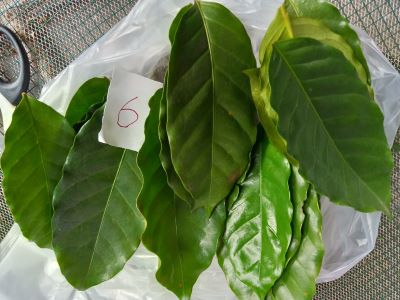
Response of mineral formulation towards different growth phases of arabica coffee in lowland
Distiana Wulanjari(1*), Ketut Anom Wijaya(2), Muhammad Ghufron Rosyady(3), Suwardiyanto Suwardiyanto(4), Susan Barbara Patricia Sembiring Meliala(5), Setiyono Setiyono(6), Oria Alit Farisi(7)
(1) Faculty of Agriculture, University of Jember
(2) Faculty of Agriculture, University of Jember
(3) Faculty of Agriculture, University of Jember
(4) Faculty of Mathematics and Natural Sciences, University of Jember
(5) Faculty of Agriculture, University of Jember
(6) Faculty of Agriculture, University of Jember
(7) Faculty of Agriculture, University of Jember
(*) Corresponding Author
Abstract
Arabica coffee cultivation is limited by altitude, which affects its production. Some farmers in Jember Regency are innovating to grow arabica coffee in the lowland, but the potential for leaf rust disease is quite high. Plant natural resistance can be enhanced by adding minerals formulation (containing silica, iodine, and calcium). This research aimed to determine which phase is more effective for applying mineral formulation that induces plant resistance. The formulation was tested on arabica coffee plants grown at the lowland (460 masl) in Jember Regency on 12 years old (y.o) mature and 1 y.o immature plants. One formulation was dissolved in 14 L of water and applied by foliar feeding. The effect was analyzed using two-way T-test of two samples assuming unequal variances at 95% confidence level to determine the differences. The analysis showed that the plants supplemented with the formulation could increase the variables that supported the natural resistance of plants (both mechanically and through the production of chemical compounds), such as polyphenol content, flavonoids, antioxidant activity, total dissolved protein, vitamin C, reducing sugar, lignin, cellulose, hemicellulose, and iodine content in the plant. The response of the formulation application showed that the most resistance variables was better in 1 y.o immature plants than in 12 y.o mature plants. The application of mineral formulation in immature phase will have a better impact on increasing natural resistance, and it has the potential to be used as a supplement for arabica coffee plants cultivated in the lowland.
Keywords
Full Text:
PDFReferences
Dias, M.C., Pinto, D.C.G.A., and Silva, A.M.S. (2021). Plant Flavonoids: Chemical Characteristics and Biological Activity. Molecules, 26(-), pp. 1–16.
Djapiala, F.Y., Montolalu, L.A.D.Y., and Mentang, F. (2013). Kandungan Total Fenol dalam Rumput Laut Caulerpa Racemosa yang Berpotensi sebagai Antioksidan. Jurnal Media Teknologi Hasil Perikanan, 1(1), pp. 34–39.
Hasanah, M., Maharani, B., and Munarsih, E. (2017). Daya Antioksidan Ekstrak dan Fraksi Daun Kopi Robusta (Coffea Robusta) terhadap Pereaksi DPPH (2,2-Difenil-1-Pikrilhidrazil). Indonesian Journal of Pharmaceutical Science and Technology, 4(2), pp. 42–49.
Ibrahim, M.S.D., Wahyuno, D., and Hartati, R.S. (2017). Ketahanan Genotipe Unggul Beberapa Spesies Kopi terhadap Penyakit Karat Daun (Hemileia Vastatrix) Asal Cisaat Sukabumi. Prosiding Agroinovasi Spesifik Lokasi untuk Ketahanan Pangan pada Era Masyarakat Ekonomi ASEAN, -(2), pp. 1124–37.
Kanani, N., Wardono, E.Y., Hafidz, A.M., and Octavani, H.R. (2018). Pengaruh Konsentrasi Pelarut terhadap Proses Delignifikasi dengan Metode Pre-Treatment Kimia. Teknika, 14(1), pp. 87–96.
Kementerian Pertanian. (2019). Statistik Perkebunan Indonesia Komoditas Kopi 2017–2019. Direktorat Jenderal Perkebunan - Kementerian Pertanian, pp. 96.
Keraf, F.K., Nulik, Y., and Mullik, M.L. (2015). Pengaruh Pemupukan Nitrogen dan Umur Tanaman terhadap Produksi dan Kualitas Rumput Kume (Sorghum plumosum var. timorense). Jurnal Peternakan Indonesia, 17(2), pp. 123–30.
Kustiari, Reni. (2007). Perkembangan Pasar Kopi Dunia dan Implikasinya Bagi Indonesia. Forum Penelitian Agro Ekonomi, 25(1), pp. 43–55.
Li, R., Li, D.W., Liu, H.P., Hong, C.L., Song, M.Y., Dai, Z.X., Liu, J.W., Zhou, J., and Weng, H.X. (2017). Enhancing Iodine Content and Fruit Quality of Pepper (Capsicum Annuum L.) through Biofortification. Scientia Horticulturae, 214, pp. 165–73.
Martoharsono, S. (1994). Biokimia Jilid 1. Yogyakarta: UGM Press.
Nurnasari, E., and Nurindah. (2017). Karakteristik Kimia Serat Buah, Serat Batang, dan Serat Daun. Buletin Tanaman Tembakau, Serat & Minyak Industri, 9(2), pp. 64–72.
Pani, M., and Sari, R.E. (2023). Keberadaan Penyakit Karat Daun (Hemilia Vastatrix B. ET BR.) pada Ketinggian Tempat Berbeda. Jurnal Pertanian Agros, 25(1), pp. 698–702.
Pratiwi, Y.H., Ratnayani, O., and Wirajana, I.N. (2018). Perbandingan Metode Uji Gula Pereduksi dalam Penentuan Aktivitas Alfa-L-Arabinofuranosidase dengan Substrat Janur Kelapa (Cocos nucifera). Jurnal Kimia, 12(2), pp. 134–39.
Rosyady, M.G., Wijaya, K.A., Wulanjari, D., and Wafa, A. (2020). Role of Mineral Elements to Induce the Resistance of Arabica Coffee against Rust Disease at Lowland Area. E3S Web of Conferences, 142, pp. 1–3.
Siswoyo, T.A., Mardiana, E., Lee, K.O., and Hoshokawa, K. (2011). Isolation and Characterization of Antioxidant Protein Fractions from Melinjo (Gnetum gnemon) Seeds. Journal of Agricultural and Food Chemistry, 59(10), pp. 5648–5656.
Subroto, G., Kusbianto, D.E., Avivi, S., Slameto, and Setiyono. (2019). Correlation Between Secondary Metabolites of Leaf and the Resistance to Leaf Rust (Hemileia vastatrix) on Several Arabica Coffee Clones. Ilmu Pertanian (Agricultural Science), 4(2), pp. 71–75.
Sugiarti, L. (2017). Analisis Tingkat Keparahan Penyakit Karat Daun pada Tanaman Kopi Arabika di Kebun Percobaan Fakultas Pertanian Universitas Winaya Mukti Tanjungsari. Jagros, 1(2), pp. 80–89.
Suparti, Barokah, S.E., Agustina, L., and Agustina, P. (2018). Efektivitas Media Campuran Jerami Padi dan Daun Pisang Kering terhadap Produktivitas Jamur Merang (Volvariella volvaceae). Seminar Nasional Pendidikan Sains, pp. 191–97.
Triyanti, D.R. (2016). Outlook Kopi: L. Nuryati and A. Yasin, ed., Jakarta: Pusat data dan sistem informasi pertanian Sekjen Kementan.
Wulanjari, D., Wijaya, K.A., Rosyady, M.G., and Wafa, A. (2020). Polyphenol Content and Enhancing Plant Resistance of Lowland Arabica Coffee. E3S Web of Conferences, 142, pp. 1–3.
Wulanjari, D., Wijaya, K.A., and Rosyady, M.G. (2022). Aplikasi Unsur Mineral Efektif sebagai Natural Immune Booster Tanaman Kopi Arabika Lowland Fase TBM. Proceeding Semartani 1, 1(2), pp. 84–90.
Xue, Z., Wang, C., Zhai, L., Yu, W., Chang, H., Kou, X., and Zhou, F. (2016). Bioactive Compounds and Antioxidant Activity of Mung Bean (Vigna radiata L.), Soybean (Glycine max L.) and Black Bean (Phaseolus vulgaris L.) during the Germination Process. Czech Journal of Food Sciences, 34(1), pp. 68–78.
Article Metrics
Refbacks
- There are currently no refbacks.
Ilmu Pertanian (Agricultural Science) ISSN 0126-4214 (print), ISSN 2527-7162 (online) is published by Faculty of Agriculture Universitas Gadjah Mada collaboration with Perhimpunan Sarjana Pertanian Indonesia (PISPI) and licensed under a Creative Commons Attribution-ShareAlike 4.0 International License.













